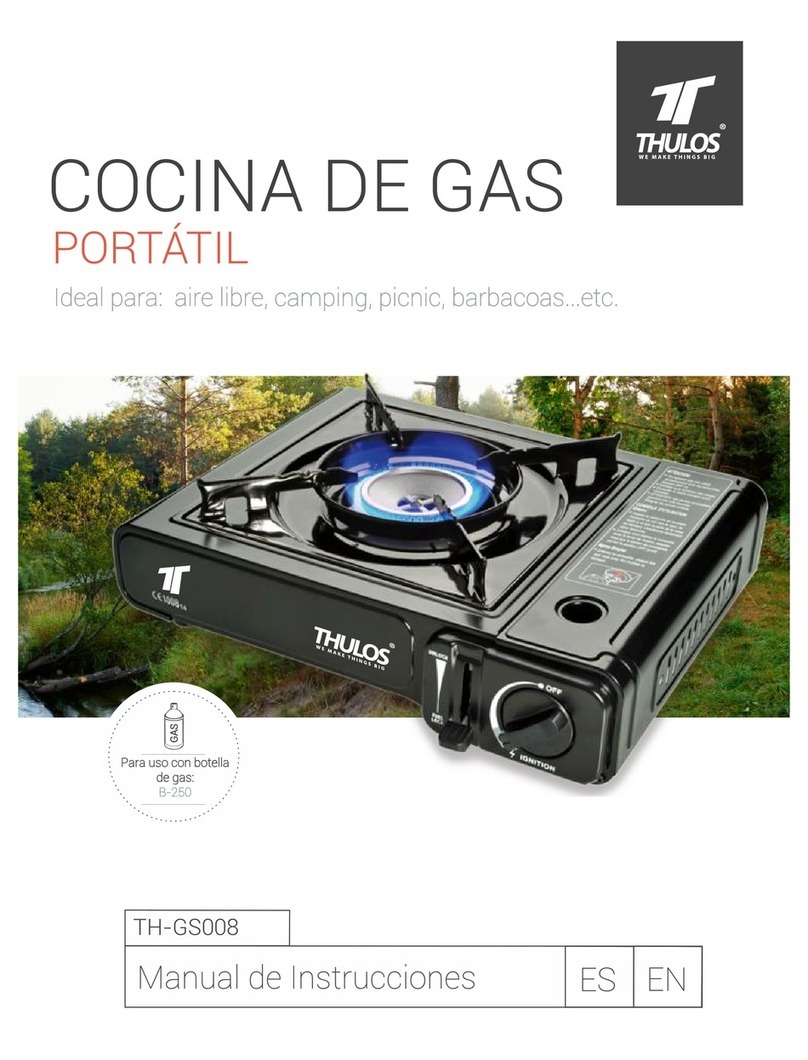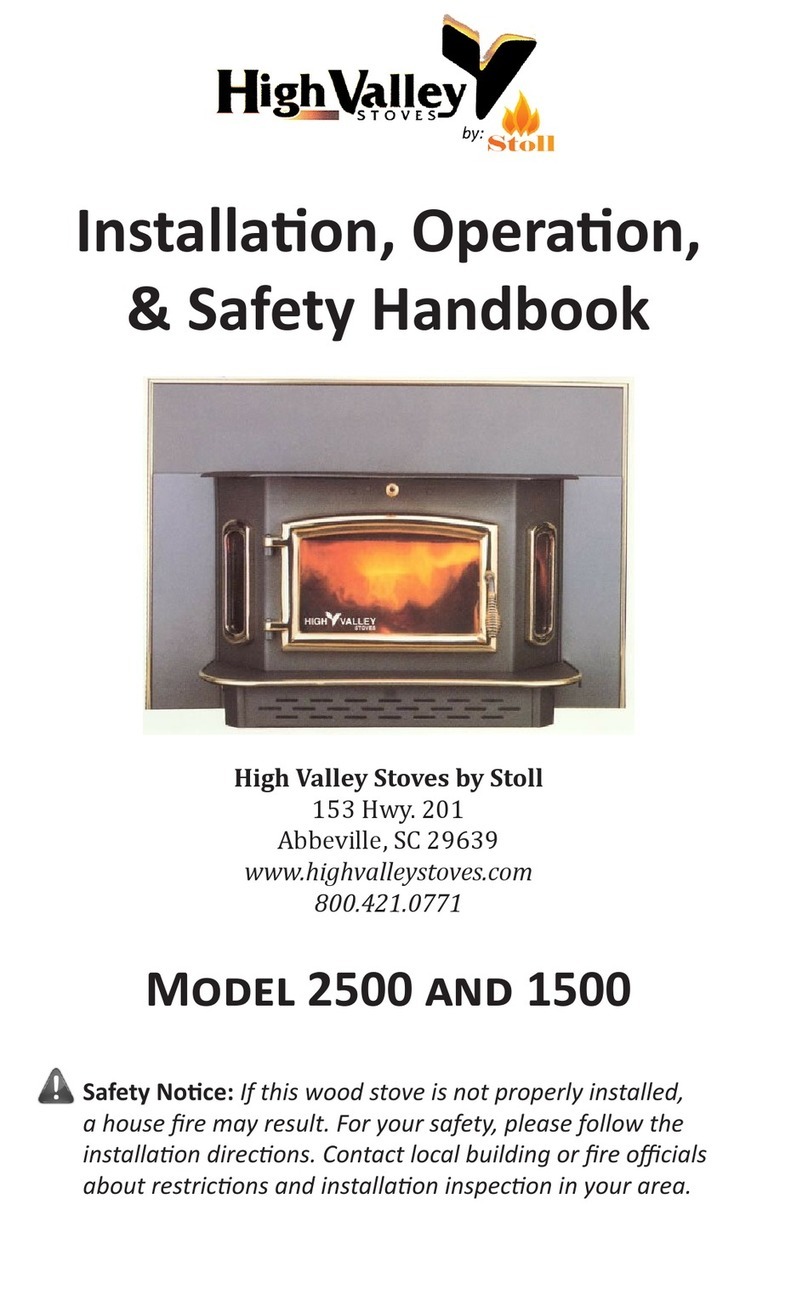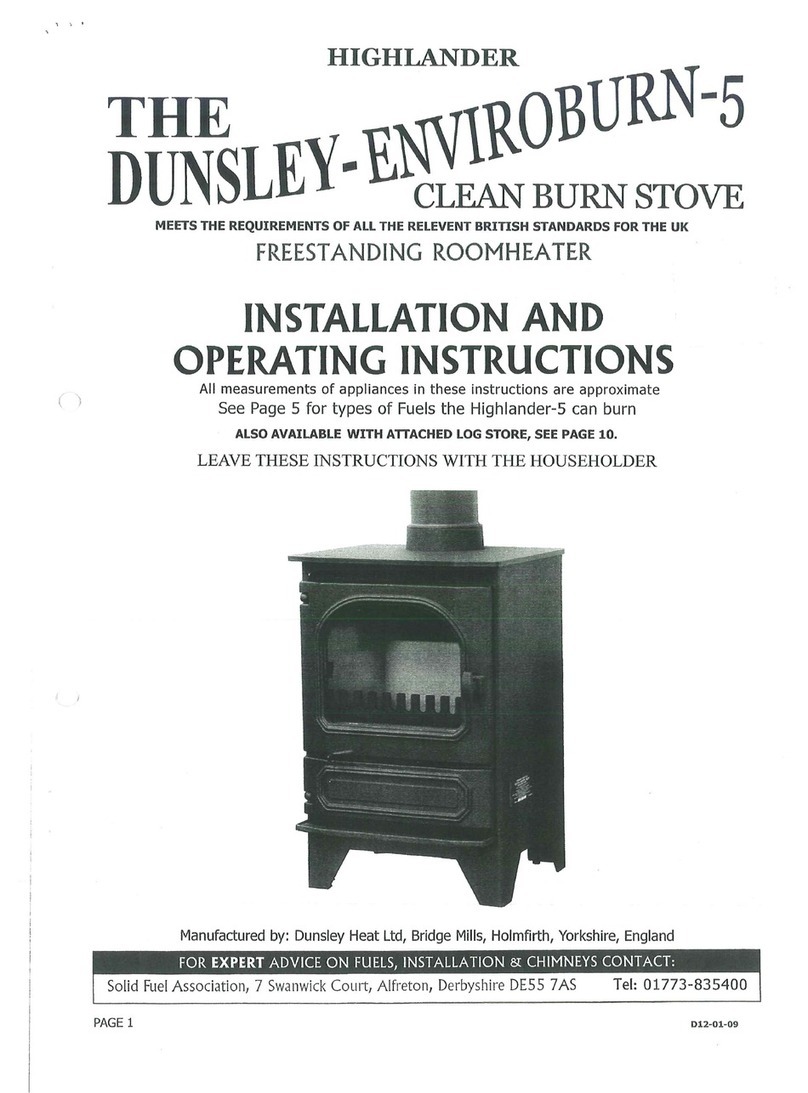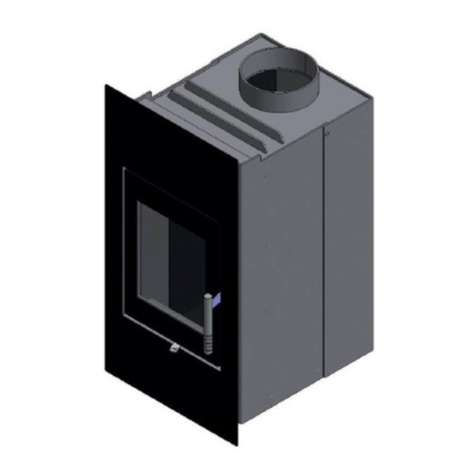BFM Europe portway User manual

Wood Fuel Stoves Manual v1. Issued - 04/02/2014 (25)
SOLID FUEL EATING STOVES
WOOD-BURNING MODELS
INSTALLATION AND OPERATING INSTRUCTIONS
LEAVE T IS DOCUMENT WIT T E OUSE OLDER!
All Portway Stoves exceed the safety and performance requirements of European Standards
Intermittent burning solid fuel roomheaters for installation with a single dedicated chimney.
Nominal eat
Output kW
Fuel Efficiency
(Net) %
Flue
gas
temp.
rise°C
Emissions at nominal output
related to 13% O2Min. Safe
Distance to
Combustibles
Tested to
Standard or to
Technical
Document
Tested when and
by (name and
number if a
notified body)
Room Water
CO % Smoke
mg/m³
NOx
mg/m³
Gas
Flow
g/sec
CxHy
mg/m³
DeepWood
No2 11.0 -Wood
Logs 76.3 339 0.1 72 98 8.2 85 400mm
EN
13240:2001+
A2 2004
SGS Nederland
BV No0608
June 2013
DeepWood
No3 14.8 -Wood
Logs 74.4 339 0.1 c130 - - - 400mm
EN
13240:2001+
A2 2004
EN13240 family
clause 9.2.2
Read these instructions! Use only recommended fuels!
This document, when completed by the installer, constitutes part of a 'Hearth Notice' for purposes of
Building Law. It must be left with the householder and placed where it can easily be found.
INSTALLED AT LOCATION:
BY:
EMERGENCY CONTACT:
Flue Draught
measured on
commissioning:
Fuel used on
commissioning
I definitively assert that this installation is safe, has been lit and demonstrated to the
householder, conforms with current building regulations and with these instructions
SIGNED: DATE:
TO FIND A QUALIFIED INSTALLER, FUEL SUPPLIER or C IMNEY
SWEEP, CONTACT:
UK: The Solid Fuel Association, 7 Swanwick Court, Alfreton, Derbyshire
DE55 7AS Tel:0845-601-4406 www.solidfuel.co.uk
RoI: Irish Nationwide Fireplace Organisation, 162 Capel Street, Dublin 1
Tel:01-801-5959 www.fireplace.ie
Trentham Lakes, Stoke on Trent, Staffordshire, England ST4 4TJ
www.bfm-europe.com Tel 01782 339000 Fax 01782 339009
Portway DeepWood No2 and No3 stoves may be used in Smoky Fuel Ban areas of the Republic of Ireland when burning Wood logs
or peat briquettes, but not petroleum coke (Control of Atmospheric Pollution Regulations, 1970)
The Portway DeepWood No2 stove only may be used in smoke control areas of the United Kingdom when operated strictly in
accordance with these instructions and with Soliftec Smoke Advice Sheet No1 (www.soliftec.com/smokeadvice.htm) when burning
untreated wood logs (Exempted from s20 of the Clean Air Act 1993)
1
Pa
WG
PRODUCTION NUMBER

IN 1830 Charles Port ay built a stove to heat his ironmongery shop at Halstead in Essex. It as
so good that his neighbours started asking for them. Mr Port ay had done something completely
ne - designed his stoves right from the start to give out the maximum heat from the minimum
fuel, so that he is kno n as "The Founding Father of Energy Efficiency". The stoves that bear
his name are still made in Britain by the direct successors of the company he established.
Building regulations are available at www.soliftec.com
INSTALLING a stove is a 'controlled service', the law expects that
it is either supervised by a qualified installer or that the building
inspector is informed. Check with your local authority.
ASBESTOS: Your stove does not contain asbestos, but take care
to avoid disturbing asbestos in an old installation.
WEIG T: Your stove is heavy - take great care when moving it
and ensure that the intended fireplace can support the weight-
consider fitting a load distributing plate.
YOUR C IMNEY, by becoming warm, makes the gas inside it
rise, pulling fresh air into the stove to make it work. It must:
• Generate a draught in use of at least 12Pa (0.05ins wg)
• Be capable of withstanding the temperatures generated.
• Be absolutely incapable of leaking fumes into the dwelling
• This will commonly be achieved by it:
• Being at least 5m high.
• Terminating at least 1m above any roof ridge.
• Having an internal cross-section not less than 0.018m² (eg
150mm dia) and never more than 0.14m² (eg 375 x 375mm)
• Being free from even the slightest crack or source of leakage.
• Having no bends sharper than 45º.
• Being entirely free of obstructions and swept by a qualified
chimney sweep.
• Being connected only to this one appliance.
• Being of thick masonry or otherwise adequately insulated.
• Conforming to local building regulations.
Special rules apply where the flue passes through timber, thatch or
other vulnerable materials- take specialist advice.
Although it is possible to access the chimney through the fire with
the throat plate removed, fit hatches to provide access if needed.
YOUR FIREPLACE: Stoves become VERY hot, the setting must
be made entirely of durable fireproof materials. Thin (<50mm)
stone slabs risk cracking unless cut into sections to allow for
expansion and backed with a heat resistant concrete. Even
beyond the safety clearances given on the front page items can
still become very hot - take great care in siting wax, paper etc.
AIR SUPPLY: Your stove needs air to breathe - there must be a
permanent fresh air supply into the space in which it is installed
equal to the size given on page 1. This can sometimes be
provided by air leaking around door frames etc. (it is commonly
accepted that this alone may suffice for the first c.5kW in less well-
sealed buildings) but in any case of doubt, fit a purpose-made air
vent. An extractor fan, or another fuel-using appliance in the same
building, can remove this air.
BOILER: A slot-in water boiler for domestic hot water and/or
radiators is available as an option. Please refer to the installation
details provided with the boiler.
FITTING
Fasten the flue outlet and blanking plate to the top or back flue outlet and fit the stove to a a solid non-combustible hearth
conforming to building regulations. Your stove can be sealed to the chimney using a short length of uninsulated 150mm diameter
pipe in several ways, four of which are shown.
Rear outlet to top outlet by
'T' piece with cleaning door-
the preferred method.
Through steel or concrete closure plate (with
cleaning door) into old, oversized, chimney.
Steel sealing collar. 'L' fixings also shown.
45º top outlet sleeved through
wall into external insulated flue.
Cleaning hatches on bends.
Rear connection into chimney
with sealing collar. Cleaning
door on opposite side.
Whichever method is used it is imperative that: (1) The route for gases from the stove to the chimney terminal is completely air-tight;
even the tiniest gap or crack can spoil the updraught. Seal all joins with fireproof cement and/or heatproof rope. (2) It is possible to
sweep the entire length- access doors may be required. (3) The entire construction is of durable fireproof materials. (4) It is wise to fit a
CO alarm.
C ECK T E INSTALLATION !
Once installed, light the fire, demonstrate it to the householder and
check that:
1) It burns controllably and does not emit fumes to the room
2) The route for gases from the stove to the chimney terminal is
completely airtight, unobstructed and able to be swept.
3) The entire construction is of durable fireproof materials.
4) The flue presents a draught in use of at least 12Pa
LIVING WIT YOUR STOVE
Every fuel, chimney and condition of use is different. Only
experience will show which are the best settings for you.
LIG TING If lighting after a period of non-use, do check that the
flueways and chimney are completely clear. Place two or three
firelighters close together, or screwed-up paper covered with dry
sticks, at the back of the firebox and light them. When they are
burning well gently fill the fire with dry fuel, close the door and set
2
T IS APPLIANCE BECOMES EXTREMELY OT
AND CAN PRODUCE POISONOUS GASES.
A fire-guard should be used if children or the infirm are
present. The installer is required to EXACTLY follow
these instructions and to completely comply with all
local, national and international standards.

all the air control slides to the open position. When the fire is
burning well, move the controls to the lowest practical setting.
FILLING: Two or three logs of about 2kg each are all that is
normally needed for full output. Don't fill the stove with logs so high
that they touch the steel baffle plate over the firebox.
CONTROL How
fast the fire burns
depends on how
much air reaches
the fuel. The
stove's main
control is a an
'airwash' slider
above the fire
opening, move it
to the right for
highest output, to
the left for 'low'.
There is a second
air control on the
door, below the
window. This can
be opened to
provide extra air to get the fire going quickly, but should be kept
shout in normal operation.
The controls can get very hot, so move them only with the handle
supplied.
EMPTYING AS ES. The effectiveness of this appliance depends
on always burning fresh wood on top of the residues from the
previous fire, so DO NOT empty ash until absolutely necessary.
The white powdery material left after a fire has burned away is not
ash but flakes of cellulose – it will burn away the next time you
light a fire on top of it so that the only thing left to remove is the
true ash, a slightly gritty brown powder. Remember to let ash cool
before disposing in plastic sacks or dustbins.
KEEPING T E WINDOW CLEAN Simply operating the stove for a
few minutes at high output will often burn-off any deposits left by
tarry or wet fuels. Severe stains can be removed when cold with a
domestic bleach cleaner. The window is not glass but a
transparent ceramic, it may develop tiny hairline cracks, these are
harmless, and a characteristic of the toughest and most heat-
resistant material known. Reduce the risk of staining by using only
very dry fuel and keeping the airwash control slightly open.
OPENING T E DOOR This stove is designed to be operated only
with the door closed. Open the door very slowly to minimise fume
emission and prevent hot fuel falling out. Remember that the
whole stove becomes extremely hot. Pull the door handle off when
not being used to prevent it overheating.
SUMMER S UT DOWN: Before a long period of non-use, empty
fuel and ash, remove the throat plate and leave all the air controls
open to allow ventilation to reduce condensation.
FUEL
This is a wood-burning appliance. It is only capable of burning dry
volatile vegetable fuels such as wood logs, straw briquettes or
compressed leaf fuel. It will not burn coal, coke or any form of
mineral fuel.
SMOKE CONTROL: In certain areas special rules apply to reduce
smoke nuisance. Check with your local authority.
WOOD only emits as much carbon to the atmosphere as the tree
took in when growing, so wood is considered the 'carbon neutral'
fuel. When wood is cut down its cells are full of water. Burning
such wet or 'green' wood wastes heat in making steam and
produces flammable, acidic tars which will cling to, and rapidly
damage, your stove and chimney. Split logs will typically take two
years to become reasonably dry, round logs very much longer.
Cracks in the ends, a hollow sound when tapped and bark falling
away are all signs that a log may be ready for use.
The fine, white residue produced when
wood burns is not ash, but the remains
of cell walls which can burn if kept hot
enough, so don't de-ash the fire until
absolutely necessary when using
wood.
For best performance, and al ays for low smoke emission:
• Split logs lengthways for drying
• Ensure logs are absolutely dry (less than 15% moisture)
• Fill the stove criss-cross, so air can circulate between logs.
• Fill 'little and often'
• Always have the airwash control at least a little open.
• When first lighting, or reviving a fire from embers, use only very
small, thin, dry, sticks.
• Don't empty the ash out until absolutely necessary.
JOINERY WASTE Dry wood offcuts will burn well, but don't
expect softwood waste to burn as cleanly or for as long as
hardwood logs.
PROBLEMS?
Problems like those listed here are usually due to some difficulty
with the installation, chimney or fuels, so please check back
through this leaflet carefully. If necessary seek specialist advice.
SMOKE FROM T E C IMNEY Use only VERY dry wood and
make sure the airwash control is at least a little open in order to
burn the smoke away.
DAMAGED LINERS The Portway stove gets very, very hot inside,
it is quite usual for the replaceable liners to crack or craze. They
need only be replaced when they have almost completely
disintegrated. Help them last longer by using only very dry fuel.
WOOD SMELL The human nose is able to detect wood smoke in
almost unbelievably tiny concentrations. It is very unlikely that you
will be able to operate a domestic wood stove without some smoke
smell. There is no evidence that, as normally encountered, it is
harmful
POOR EAT OUTPUT: A stove can heat a typical room of about
12m³ volume for each kW of output, so a 5kW model can heat up
to (12 x 5) 63m³, a room of about 5m square. The actual size
depends on the insulation and air-change ratio of the room. To
attempt to heat a larger room will result in excessive fuel
consumption and damaging overheating.
LACK OF CONTROLLABILITY Wood may burn excessively until
the gases in it has been used up. You can reduce this effect by
making sure that the fire is very low before refuelling and checking
that the door seals fully.
DIFFICULTY BURNING FOR EXTENDED PERIODS If the fire
goes out with fuel still in the firebox, then this is probably because
too little air has been reaching it, try leaving the air controls open a
little more. Check that the door seals are sound and that there are
no cracks or gaps anywhere in the flue.
T E DOOR CATC may need
adjusting as the rope seal
'beds down'. Simply loosen the
screw at the end of the shaft
and move the tapered pin as
shown. Re-tighten the screw.
CONDENSATION onto cool surfaces inside the stove can be
severe if the fuel is in any way damp. Use only very dry fuel.
OVER-FIRING: It is possible to leave the fire too long with the
controls set too high leading to 'over firing', seen as glowing metal
parts, excessive chimney temperature and risk of parts failing or
chimney fires. Always set controls to the lowest practical setting. A
chimney thermometer, from your local stove shop, can help.
SMOKE COMING INTO ROOM Fumes are poisonous- smoke
emission must NEVER be tolerated, causes might be:
NEW STOVE: There is often a smell and sometimes visible fumes
as the paint cures. This normally stops after an hour or so.
INADEQUATE SEALS: Are all flue pipes and connectors
absolutely gas-tight? Even the tiniest crack or gap can spoil the
draught. Does an inset appliances fully seal against the fireplace?
BLOCKED THROAT PLATE: Has soot and ash collected on the
'throat plate' above the inner back part of the firebox?
UNSUITABLE, BLOCKED OR UN-SWEPT CHIMNEY: The first
requirement for correct operation is a sound chimney. Check the
requirements earlier in this document and in any case of doubt
engage a professional sweep or chimney engineer.
POOR AIR SUPPLY: Lack of air to the fire is a common cause of
smoking and poor performance. Air supply problems may be
3

worse in certain wind conditions (often incorrectly ascribed to
'downdraught', which is in fact very rare), where air can be sucked
out of the room. The answer is to fit an air vent, as near to the fire
as possible, facing into the usual wind direction.
DOWNDRAUGHT: Wind can blow do n a chimney if there is
something higher nearby such as a tree, hill or high building.
Fitting an anti-downdraught cowl to the chimney top can cure this.
Types which cannot be swept through are not recommended.
POOR CHIMNEY DRAUGHT- Chimney draught in use MUST be
at least 12Pa.
C IMNEY FIRE: In the rare event of deposits inside the chimney
igniting (roaring sound + dense smoke and sparks from the
chimney) immediately close the door, shut all air controls and call
the fire brigade. Prevent fires by using very dry fuel and having
your chimney swept regularly.
MAINTENANCE
MONT LY- With the fire cold, remove, clean and refit the throat
(or 'baffle') plate below the flue outlet. Check that the flue is clear
and unblocked, and that the door seals are sound.
ANNUALLY- SWEEP T E C IMNEY The entire length of the
chimney from stove to outlet should be swept annually, more often
if smoky fuels are used.
NEW PARTS Your stove has been extensively tested for safety -
please don't try to modify it and always obtain genuine spare parts.
SURFACE FINIS Wipe the stove body with a slightly damp cloth
when cool. NEVER use aerosol spray or wax near the hot fire –
they can ignite. Painted steel parts can be refurbished using
special spray paint. Coloured doors are traditional hand-applied
vitreous enamel - it ill have small surface imperfections and,
while virtually immune from fading, rust and scratches, it can chip.
Enamel cannot be repainted or repaired.
Your stove generates VERY high temperatures. Eventually the
internal parts will require replacement . Help parts to last by:
• Using only very dry logs
• Cleaning the throat plate regularly.
• Avoiding 'over-firing'
PARTS AND ACCESSORIES
When ordering parts, specify the model of Portway Wood stove you have, and which colour.
Portway spares Tel. 01782 339034 Fax 01782 339028
1Boost boiler for all free-standing models
2Throat plate
3Replaceable Liner - rear
4Replaceable Liner - sides left or right
5Replaceable Liner – base segments
6Transparent window
7Rope seal kit
8Door (Various styles are available)
9
Window trims - can be added at any time
10 Ashpan
11 Door catch
12 125980 Removable door handle
13 125920 Ashpan handle
14 Inner Baffle
15 Hinge Pin
16 Cast Top
17 Cast base trims
18 Grate
-126110 Masonry fixing screws - self tapping.
-Touch-up paint, black or charcoal.
Trentham Lakes, Stoke on Trent, Staffordshire, England ST4 4TJ
www.bfm-europe.com Tel 01782 339000 Fax 01782 339009
4
The Portway stove designs are registered at the UK Patent Office and protected by Copyright © and UK Design Right, Glyn Hughes 2006-2009. Certain parts are UK Patent Applied
For. This document printed 04/02/2014. We are always striving to improve these products and may change their specification without notice.
Popular Stove manuals by other brands
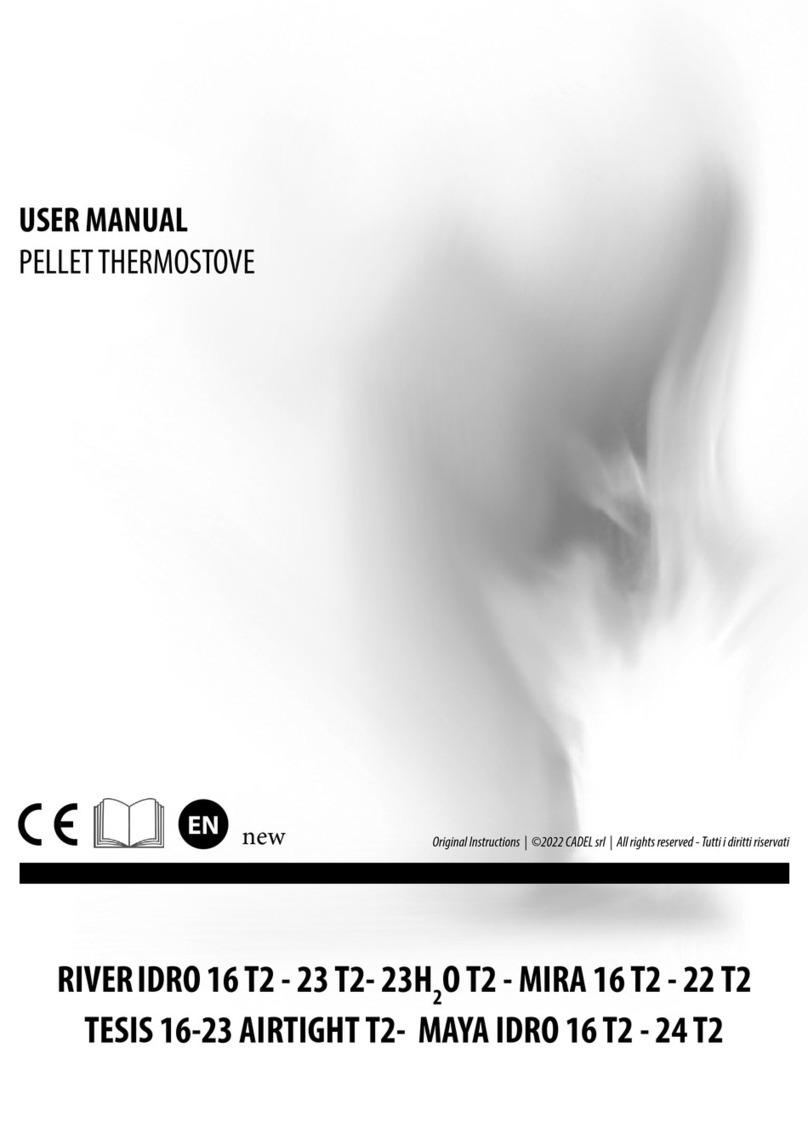
Cadel
Cadel TESIS 16 AIRTIGHT T2 user manual

Henley Stoves
Henley Stoves Yale 8 Wood Installation & operating instructions
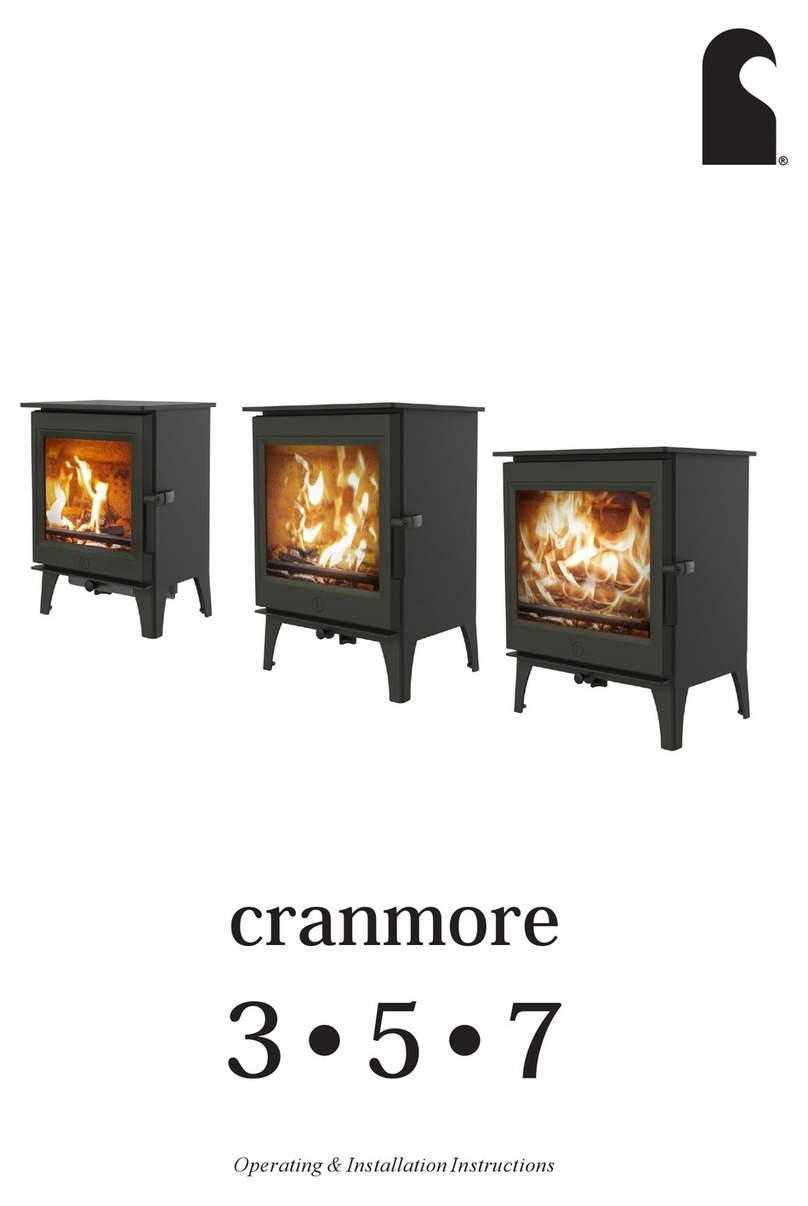
Charnwood
Charnwood CRANMORE 3 Operating & installation instructions

Arada
Arada Aarrow user guide

Saltfire
Saltfire ST-X4 Tall Installation and operating instructions

Super Ego
Super Ego SEH025300 Instructions for use

Drolet
Drolet ECO-55 ST Operation manual
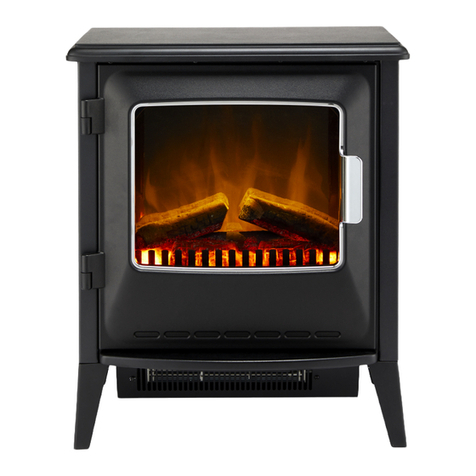
Dimplex
Dimplex Lucia LUC20-EU instructions
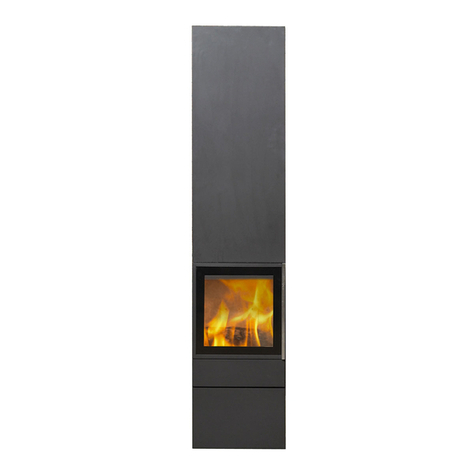
Jydepejsen
Jydepejsen Trendline 1 Installation and user manual

Vermont Castings
Vermont Castings Encore 2550 Service manual

lifelong
lifelong LLGS23-2 quick start guide

klover
klover BI-FIRE MID Installation, use and maintenance, useful tips


